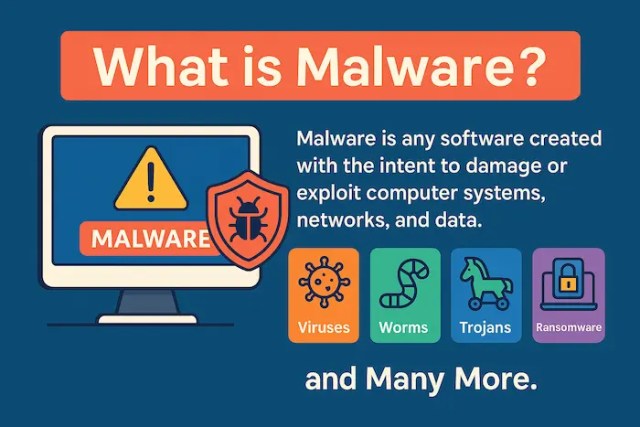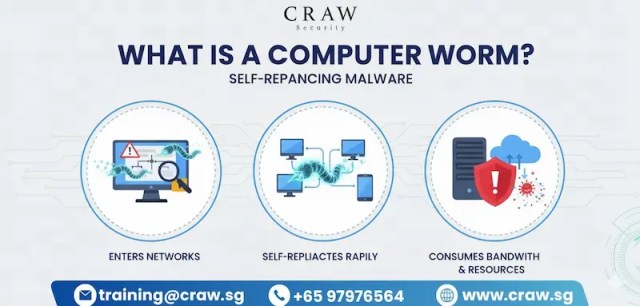- Email: info@craw.sg
- Phone: +65 9797 6564

Let’s take a look at the Difference Between Virus, Worm, and Trojan Horse and see how you can evade them! Several companies go through cyberattacks and don’t get much time to prevent them.
Here, we will talk about some of the most dangerous cyber threats and suggest the best security solution. What are we waiting for? Let’s get started!
Any software that is purposefully meant to harm a computer, server, client, or network is referred to as malware. Spyware, ransomware, worms, and viruses are only a few of its many possible forms.

Malware’s main objectives are to interfere with computer functions, steal confidential information, or obtain illegal access to private computer networks. Let’s take a look at the “Difference Between Virus, Worm, and Trojan Horse!”
The following are some types of malware:
| S.No. | Factors | What? |
| 1. | Antivirus software is 100% effective | Since complex threats can avoid detection and new malware is generated every day, no antivirus program can provide total protection. |
| 2. | Only malicious websites can infect you | Malware can be obtained from a variety of sources, including compromised USB drives, email attachments, and even trustworthy websites. |
| 3. | Macs and Linux are immune to malware | Macs and Linux systems are not immune and have been targeted by particular malware, despite having a smaller user base and differing security mechanisms. |
| 4. | The only people who get malware are those who visit shady websites | Anyone can become infected with malware through safe means such as supply chain attacks, fraudulent ads on popular websites, or phishing emails. |
| 5. | A computer’s performance is the only sign of infection | Many sophisticated malware strains are made to operate covertly in the background, which makes it challenging to identify them and prevents any discernible performance changes. |
| 6. | Malware only affects large companies | Because they may have fewer security measures and are therefore easier targets, cybercriminals frequently use malware to target people and small businesses. |
| 7. | Cleaning a virus is easy | Malware removal can be a difficult procedure that frequently calls for certain equipment and knowledge to guarantee that the threat is totally eliminated and the system is returned to its pre-infection state. |
Malicious software that needs a host application to infect and propagate is called a computer virus. After attaching itself to a trustworthy file or document, the virus becomes active and can spread by infecting other programs on the computer with its code.

A virus depends on the user to unintentionally spread the infection since, unlike worms, it cannot replicate itself without human involvement.
A computer worm is an independent, harmful program that has the ability to replicate and propagate over computer networks. In contrast to a virus, it can spread without human contact or attachment to a host file or application.

Worms automatically move from one machine to another by taking advantage of software flaws; as they expand, they frequently congest networks and transfer additional harmful payloads.
Malicious software that poses as a trustworthy or helpful application to fool a user into installing and using it is known as a Trojan horse. Once inside, it can download further malware onto the system, steal confidential data, or open backdoors for attackers.

A Trojan’s main function is to trick a user into granting it access to their computer; unlike viruses or worms, it does not replicate itself.
| S.No. | Factors | Topics | What? |
| 1. | Replication Method | Virus | Viruses spread by attaching themselves to trustworthy applications or files. To propagate, they need human involvement, such as opening an infected file. |
| Worm | Worms may proliferate on their own and replicate themselves. They can spread by taking advantage of network flaws and don’t require an attachment to a host file. | ||
| Trojan Horse | It is impossible for a Trojan horse to replicate itself. Its only objective is to trick a user into installing it voluntarily by disguising itself as a trustworthy or practical application. | ||
| 2. | Host Dependency | Virus | A virus isn’t a program in and of itself. For it to activate and spread, it needs a host software to infect and must be executed on that host. |
| Worm | A worm is a harmful program that runs on its own. It may travel across networks without any human contact and does not require a host to survive or proliferate. | ||
| Trojan Horse | Trojan horses are stand-alone programs as well, although they only utilize user execution and social engineering to obtain initial access. They don’t automatically spread to other files or systems. |
The following are the impacts of these threats on cybersecurity:
| S.No. | Factors | What? |
| 1. | Use and Maintain Security Software | To find and eliminate harmful software, install and update a trustworthy antivirus or anti-malware program on a regular basis. |
| 2. | Keep All Software Updated | Update and patch your operating system and all apps on a regular basis to address security flaws that malicious software can take advantage of. |
| 3. | Practice Safe Browsing and Email Habits | Avoid downloading files from unreliable websites and use caution when clicking on links and attachments from senders you don’t know. |
| 4. | Use a Firewall | To prevent unwanted access to your system, turn on a firewall to monitor and manage all incoming and outgoing network traffic. |
| 5. | Regularly Back Up Your Data | Make regular backups of your critical information on a cloud service or external drive so you can recover it in the event of a ransomware attack or other virus that destroys data. |
Now that we have gone through the Difference Between Virus, Worm, and Trojan Horse, you might be wondering where you could get the best services to protect yourself against such threats.
For that, you can rely on Craw Security offering the Vulnerability Assessment and Penetration Testing Services in Singapore for various sectors working in the IT Industry. Improving security standards will be possible after you get the VAPT services and security solutions from experts. What are you waiting for? Contact, Now!
1. What is the main difference between a virus, a worm, and a Trojan horse?
The primary distinction between the three is how they propagate and replicate: a Trojan horse tricked a user into installing it, a worm is a stand-alone software that replicates itself, and a virus requires a host file and human contact.
2. How does a computer virus spread?
When an infected file is accidentally opened or used by a user, the virus can attach its code to other files and programs on the system and spread to other devices through email, downloads, or external storage.
3. Can worms infect a system without user interaction?
Yes, computer worms are made to replicate themselves and can spread throughout networks by taking advantage of software flaws without requiring user intervention.
4. Why is a Trojan horse considered more deceptive than other malware?
The Trojan horse is considered more deceptive than other malware in the following ways:
5. Do viruses, worms, and Trojans all cause the same type of damage?
No, even though they are all malware, the ways that viruses, worms, and Trojan horses behave vary in the kinds of harm they can do.
6. How can I tell if my computer is infected with a virus?
You can tell your computer is infected with a virus while considering the following factors:
7. What are the common signs of a worm attack on a network?
The following are some of the common signs of a worm attack on a network:
8. How do Trojan horses usually trick users into installing them?
Trojan horses usually pose as desirable or innocuous items, such as a free game, a practical software tool, or an attachment in a phishing email that seems authentic, to fool people into downloading them.
9. Which malware type spreads the fastest: virus, worm, or Trojan?
Because worms can replicate and spread across networks on their own without human intervention, they are the most rapidly spreading malware form.
10. Can antivirus software detect all three types of malware?
Yes, contemporary antivirus software is made to identify and stop all three kinds of malware, although how well it works varies based on the threat.
11. What is an example of a famous worm or Trojan attack in history?
Two well-known examples include the Stuxnet Trojan, which was infamously used to disrupt an Iranian nuclear plant, and the ILOVEYOU worm of 2000, which spread quickly by email and caused an estimated $10 billion in losses.
12. How can I protect my system from viruses, worms, and Trojans?
You can protect your system from viruses, worms, and trojans in the following ways: